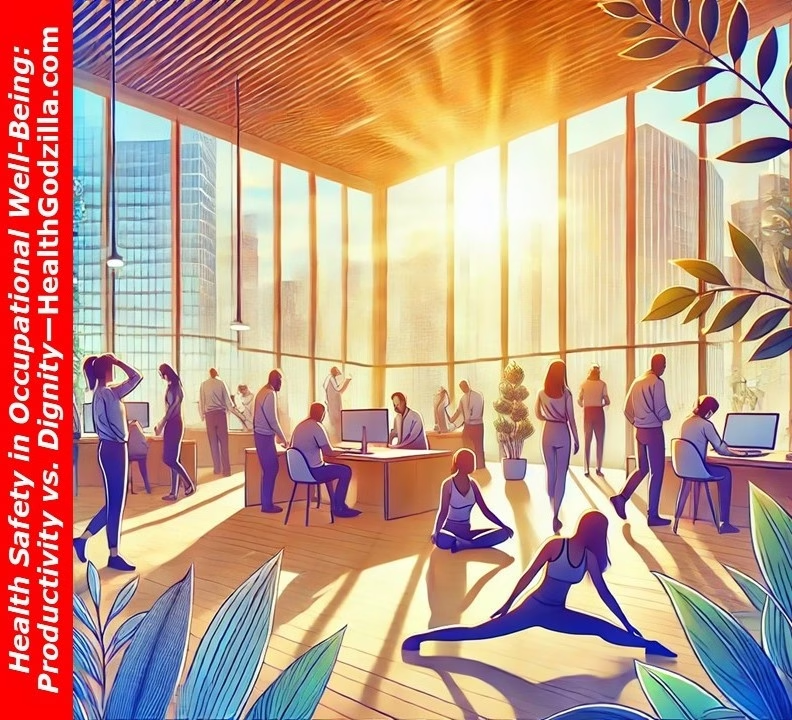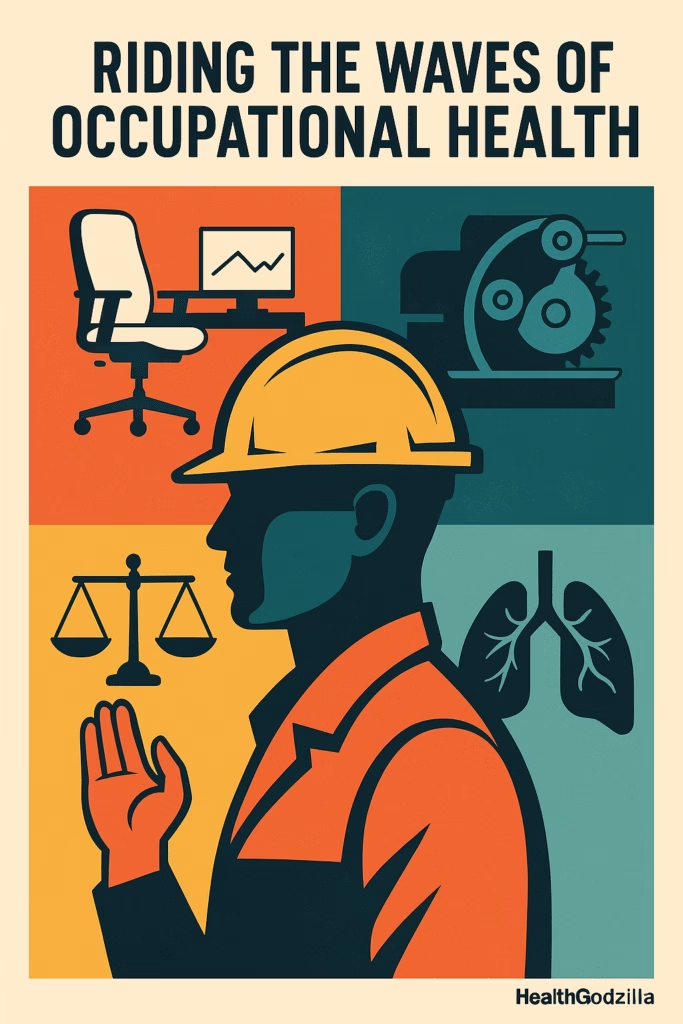
Health Safety in Occupational Well-Being is more than compliance—it’s the heartbeat of modern work. It asks not only how we prevent harm, but how we help people flourish. Picture this: stepping into work each day, not just as a duty but as an opportunity to grow, to find meaning, to thrive. The dream? A place where health isn’t merely the absence of illness but a living canvas of physical strength, mental clarity, and social connection. Yet the relationship between health and work remains a delicate dance—always balancing risk with reward.
This dance began decades ago. Since the mid-20th century, the International Labour Organization (ILO) and World Health Organization (WHO) have championed the cause of workplace well-being. In the 1950s, they offered a vision with three guiding lights: to protect and promote each worker’s health and capacity; to shape environments that safeguard both safety and dignity; and to foster work cultures where well-being isn’t a slogan but a shared responsibility. Not just for productivity—but for the soul of labor itself.
Rethinking Health at Work
The World Health Organization defines health not as the absence of disease, but as a state of complete well-being. Yet in the shifting terrain of modern workplaces, that well-being hangs in careful balance. Every workday is shaped by forces both seen and unseen—mechanical noise that never stops humming, the subtle strain of artificial light, the repetition of motion, the burden of judgment. Whether through the ache of manual labor or the quiet erosion of decision fatigue, the workplace becomes a landscape where health is constantly in negotiation.
How Work Shapes Health
Health Safety in Occupational Well-Being isn’t just a matter of helmets or air filters—it must reach the mind. The mind, too, carries its own load. Traits like Type A behavior—driven by urgency, ambition, and competition—are closely linked to elevated risks of stress-related ailments, including heart disease. But stress doesn’t always shout. It drips in through cracks—job insecurity, relentless workload, the quiet erosion of autonomy. Unnoticed at first, it gathers mass, leading to absenteeism, thinning productivity, and quietly unraveling well-being.
Karen Danna and Ricky W. Griffin’s research deepens this picture. They describe how the effects of work don’t stop at the office door. This “spillover” shapes life satisfaction far beyond clocked hours. A healthy workplace can brighten life beyond it. But a toxic one? It stains. Slowly, silently, it seeps into home, relationships, and rest—until the self no longer knows where the workday ends.
Tracing the Links Between Work and Illness
The International Labour Organization (ILO) has long studied how specific workplace exposures translate into disease. Their List of Occupational Diseases—most recently revised in 2010—now names nearly a hundred conditions linked to work. But this catalog wasn’t built in haste. It emerged over decades, through research, expert consultations, and deep reviews of hazards—chemical, physical, infectious, even psychological.
These conditions are grouped not by symptoms alone but by their roots: what agents caused them, what organs were affected, and whether they qualify as occupational cancers or system-wide ailments. But the risks resist neat boxes. Chemical exposure, repetitive strain, poor posture, or invisible toxins can each leave their mark—on lungs, skin, muscles, or minds. Health Safety in Occupational Well-Being depends on recognizing this complexity. Protection, then, is not a single tool but a full toolkit: ventilation systems, ergonomic design, early diagnosis, and yes—support for mental health, too.

Riding the Waves of Occupational Health
Occupational safety didn’t arrive fully formed—it rode in like a tide, each wave shaped by the times. The first wave was mechanical: guard the machines, stop the accidents, save the hands. Then came the 1960s and ’70s, when attention shifted inward—to posture, fatigue, and the hidden fault lines of human error. By the 1990s, a third wave rolled in: safety as culture. Not just rules, but rituals. Not just compliance, but collective awareness. A resilient workforce, it turned out, required more than helmets—it needed harmony.
Now, we sail in what many call the adaptive age, where Health Safety in Occupational Well-Being is no longer about erasing variability, but honoring it. Human performance, once seen as a risk, is now a resource. Like sailors learning to read shifting winds, organizations adapt—adjusting sails instead of cursing the storm. Every worker, with their quirks and wisdom, becomes a part of that shared vessel. Safety isn’t static. It listens. It bends. It learns.
Emerging Risks in the Modern Workplace
The landscape of work has always shifted, but now the winds change faster, and with finer particles. Health Safety in Occupational Well-Being must now navigate a sky filled with emerging risks—more elusive, more intricate than before. Job insecurity, work intensification, and the quiet encroachment of screen-bound lives have reshaped the cabin of modern labor. These aren’t just physical hazards; they are psychosocial crosswinds—unseen, but capable of destabilizing minds and bodies alike.
Take screen time: hours lost in stillness, eyes locked, bodies unmoving. Inactivity now whispers risk into the arteries, the spine, the spirit—contributing silently to heart strain and mental unrest. And what of nanomaterials? These particles, impossibly small yet deeply potent, move like dust in a sunbeam—slipping through gloves, masks, and filters. They enter the body unseen, raising new questions about their effect on lungs, blood, and brain. As science chases their trail, the guardians of health must evolve. Protection now demands foresight, not just fences. Safety must imagine what isn’t yet visible.
From Protection to Flourishing: A Holistic Shift
The true challenge isn’t only to prevent harm—it’s to plant the conditions where people can grow. This is the philosophy of salutogenesis: a forward-looking approach that asks not what breaks us, but what builds us. Health Safety in Occupational Well-Being must evolve from the language of shields to the practice of sunlight. In this view, health isn’t something preserved in jars; it’s cultivated—through connection, meaning, and care.
This shift calls on employers to do more than guard—they must garden. That means designing work that nourishes: social support systems, spaces for stress to breathe, programs that foster resilience, and opportunities that stitch meaning into daily labor.
But health can’t bloom in isolation. The WHO’s Healthy Workplace Model and NIOSH’s Total Worker Health initiative remind us that well-being is a shared harvest. Employers, employees, systems—all must tend the soil. After all, health doesn’t come with a switch to flip at the office door. It flows—through home and shift, mind and muscle, Monday and midnight.
A Collective Responsibility
Health Safety in Occupational Well-Being is not a solitary task—it is a shared current running through every corridor of labor. It begins with the worker, yes, but does not end there. It ripples outward—into homes, neighborhoods, and nations. When well-being is neglected, the cost isn’t measured only in hospital bills or lost hours. It echoes in the quiet breakdown of communities, in the erosion of trust, in the invisible toll paid by families and futures alike.
As the global economy shifts and reshapes itself, workplaces must evolve—not only to shield, but to uplift. Like a symphony, where each instrument listens as much as it plays, the guardians of occupational health—employers, regulators, workers—must find harmony in responsibility. Not perfection. Not control. But care. We do not build thriving workplaces with policies alone. We build them with presence.
And perhaps that is the quiet revolution: not treating health as a cost to manage, but as a possibility to tend.

🍂 Hello, Artista
The kettle had just finished singing when Organum called.
“Do you ever think about what doesn’t get written in safety manuals?” he asked, his voice a little gravelly from the Boston chill.
Artista smiled, cupping a steaming mug as Whitee dozed against one foot and Brownie gnawed thoughtfully on a corner of the rug. “You mean like… the loneliness in the breakroom? Or the way someone checks on a co-worker without being told?”
“Yes. That,” Organum said. “That quiet care that doesn’t fit on a checklist.”
Artista looked out the window at the gentle fog veiling the mountains. “I think real safety has texture. Not just helmets and gloves—but how someone breathes when they feel seen. When the job doesn’t eat their spine or steal their weekend.”
Brownie paused mid-chew as if listening.
“You know,” Artista added, “I met a woman last week—a janitor at the clinic. She told me her back hurt, not from mopping, but from never being asked if she needed help. That’s the part the policies miss.”
Organum exhaled softly. “Salutogenesis,” he whispered. “Health as presence, not just protection.”
The two friends stayed on the line a while longer. No big conclusions. Just warmth. The kind of warmth that doesn’t shout—but lingers.
✍️ Author’s Reflection
This piece began not with a headline, but with a silence.
It was the kind of silence I’ve heard in factory corridors after shifts end—in the ache of a bent back, in the sigh no one logs, in the light that flickers not from power loss, but from unnoticed exhaustion. Health Safety in Occupational Well-Being—I once thought that phrase belonged to the realm of forms and inspections. But as this article unfolded, it became something else. A question. A promise. A mirror.
Writing this, I realized that safety is not a checklist—it is a choreography. A shared movement where each footstep matters. And in this dance, protection isn’t enough. We must listen.
We’re called to imagine what isn’t yet visible.
Let foresight speak louder than fear.
What startled me most during this journey was how often the invisible weighs more than the visible. Nanomaterials that can’t be seen. Stress that never shouts. A worker’s worth measured by productivity instead of presence. It left me asking: are we building workplaces that protect the spine, but forget the spirit?
I do not offer answers here—only the act of noticing.
And I was not alone when I wrote this. Others spoke, and I listened.
A janitor’s back. A rabbit’s pause. A friend’s gravel-toned voice from Boston. The pulse of the ILO, the vision of WHO, the breath of Noorael—each became part of this quiet symphony.
If you felt something stir between the lines, then perhaps you too are part of this unfolding.
—Jamee
🌼 Articles You May Like
From metal minds to stardust thoughts—more journeys await:
- AOL-Time Warner failure: Merger, mindsets, and market myths. Explore culture clash, transient advantage, primacy, and antitrust risks.
- Beryllium exposure risks chiefly in high-tech and heavy industries. Covering workplace hazards, chronic disease, global updated guidelines.
- Biodiversity and nutrition: Reforming diets through agrobiodiversity. Policy, Traditional and Indigenous Foods, and Scientific Relevance.
Curated with stardust by Organum & Artista under a sky full of questions.
📚 Principal Sources
- Health and Well-Being in the Workplace: A Review and Synthesis of the Literature, Karen Danna Ricky W. Griffin Texas A&M University, Journal of Management 1999, Vol. 25, No. 3, 357-384
- Chapter 1 Work, Health, Safety, and Well-Being: Current State of the Art, © Springer Science+Business Media B.V., part of Springer Nature 2018, A. Jain et al., Managing Health, Safety and Well-Being, Aligning Perspectives, on Health, Safety and Well-Being
- Diagnostic and exposure criteria for occupational diseases Guidance notes for diagnosis and prevention of the diseases in the ILO List of Occupational Diseases (revised 2010)

Leave a Reply